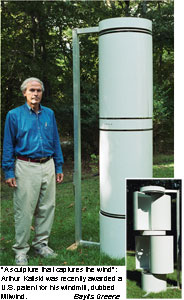Big Plans For a Little Windmill-'People say it's beautiful'

Amagansett residents may have seen Arthur Kaliski's invention before. In the summer of 2002, he strapped a keg-size vertical-axis windmill to the ski rack of his Honda Accord and rode shotgun around the hamlet with a voltmeter in his lap. The device spun on the roof and he took readings as he coursed the streets like an environmentally friendly pizza delivery man.
Three years later, this June, Mr. Kaliski was awarded a patent for his windmill, Milwind, which stands 71/2 feet tall now but remains light and transportable at 135 pounds. He wanted to come up with a simple, low-maintenance way to capture clean, renewable energy - for urban or rural settings generally, for impoverished areas overseas particularly.
"The largest use for small windmills is in third world countries," Mr. Kaliski said recently in the backyard of his house on a hill in the Amagansett woods. His windmill "could replace kerosene for lighting there," or, he said, run water purification systems that use ultraviolet light.
In this country, "it could aerate ponds or power a gate or an electric fence in a remote area. Or it could act like the photovoltaics you see on emergency phones, or on a streetlight or small utility. . . . In northern latitudes, there's not as much sun, but there's constant wind."
Milwind has a belt-driven 10-amp generator that, in its present setup, can produce 120 watts to charge a 12 or 24-volt battery. (Batteries are important, of course, for an uninterrupted supply of electricity if the wind isn't blowing.) The system can be scaled upward for increased power output.
"This is the result of three years of work - design, development, and patenting - but I originally had the idea 20 years ago." And then his partner, Millicent Danks, "saw an ad for a vertical windmill in Vermont and said, 'You better get going.' "
By vertical, Mr. Kaliski means the machine spins like a top, not a propeller facing into the wind. He called vertical windmills superior because "propeller types always need a clean airflow. They have to be high up and can't make use of turbulent air. But a vertical windmill can be sited on buildings or in places where the airflow is not constant in one direction."
In this case, the wind is caught by four cups, essentially hollow cylinders cut lengthwise - two above and two below. "The cups are a composite: a Kevlar honeycomb core and oak veneer skins, epoxied together." This keeps the windmill light and rotating easily in a breeze. "I worked with a local machinist, Peter Saskas, on the aluminum parts inside."
"The claim that earned the patent is Milwind's ability to rotate into a closed shape," in part to protect itself from bad weather. This is achieved through what he called a clutch: a small hand lever that can be lowered to brake the windmill's spin. It produces a ratcheting sound as the cups slowly close upon themselves like a flower at night. Milwind at rest stands like the world's sleekest hot water heater.
"I tried for an artistic design," Mr. Kaliski said. "People say it's beautiful. We took it to Gerard Drive to test it and some guys in a dump truck stopped to admire it. A woman walking by asked, 'Will it be here permanently?' . . . Because of the way it looks, open or closed, architects could have a field day with it."
Mr. Kaliski studied chemistry in college and sold chemicals in the Midwest for a time, but he came to put some of that technical knowledge to use in a creative way, doing restoration work on fine art. A resident here since 1997, he is a former chairman of the Sierra Club's Long Island Group, "and I was also active in getting the South Fork Groundwater Task Force going."
His interests in science, art, and environmentalism came together in Milwind, with commerce something of an afterthought. "If it makes money, fine, but I'm not trying to establish a retail market. I don't want to get into manufacturing, or a situation where by the time I'm done with it, somebody else owns it. . . . I'm trying to get licensees interested in developing it."
"The idea was to get it out there. My thing is to excite somebody who will take it up and take it to where it should go."
Tomorrow through Sunday, Mr. Kaliski will exhibit his prototype at Bioneers by the Bay at the University of Massachusetts-Dartmouth, part of a yearly environmental and alternative-energy conference at sites across the country.
As resource depletion combines with rising energy costs, "Milwind has come at an opportune time," he said. "The motive was to do some good. . . . I've always been involved in putting my two cents in in protecting the environment we live in. You become engaged because you have no other choice. You have to do it."
